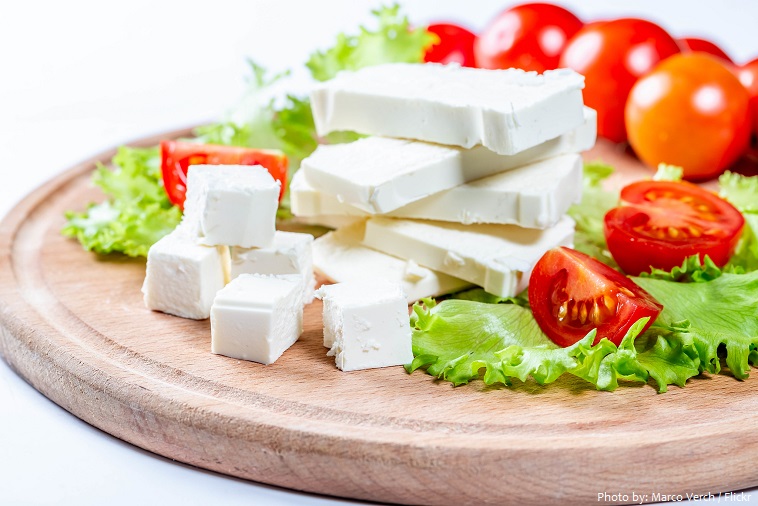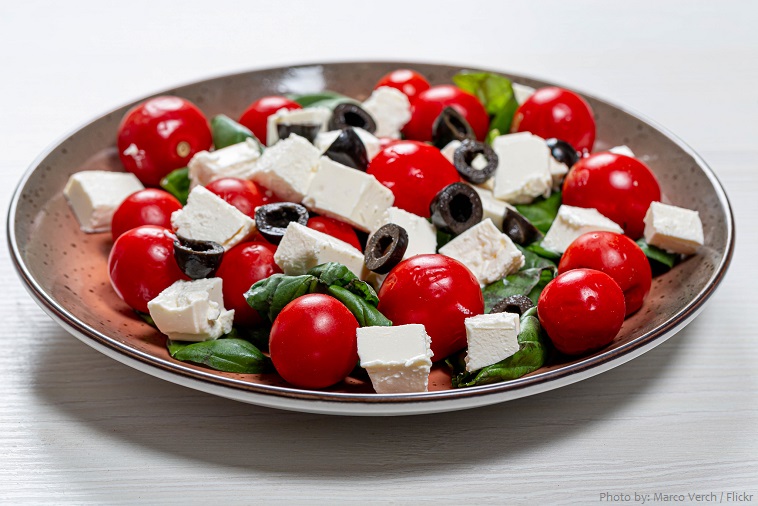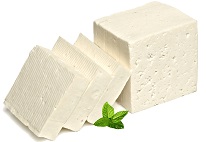Feta is a soft brined white cheese of Greece.
It is the most famous variety of white brined cheese in the world.
This cheese is made from sheep milk or from a mixture of sheep and goat milk.
It is a crumbly aged cheese, with small or no holes, a compact touch, few cuts, and no skin.
Feta is commonly produced in blocks, and has a slightly grainy texture in comparison to other cheeses.
Its flavor is tangy and salty, ranging from mild to sharp. The color is snow white on the inside and on the surface.
Feta is traditionally categorized into firm and soft varieties. The firm variety is tangier and considered higher in quality.
Feta is used as a table cheese, in salads such as Greek salad, and in pastries, notably the phyllo-based Greek dishes spanakopita (“spinach pie”) and tyropita (“cheese pie”). It is often served
with olive oil or olives, and sprinkled with aromatic herbs such as oregano. It can also be served cooked (often grilled), as part of a sandwich, in omelettes, or as a salty alternative to other
cheeses in a variety of dishes.
Feta cheese is lower in calories and fat than many other cheeses and is a good source of protein, riboflavin, vitamin B12, calcium and phosphorus.
In Homer’s Odyssey, Polyphemus the Cyclops made sheep’s milk cheese, probably a forerunner of feta, which he ripened on racks in his cave.
Though cheese made from sheep’s or goat’s milk is documented in Greece from the 8th century BC, and was widely consumed in ancient Greece and in later Greek gastronomy, feta cheese in particular is first recorded in the Byzantine period under the name prósphatos, and was produced by Cretans and the Vlachs of Thessaly.
In the late 15th century, an Italian visitor to Candia, Pietro Casola, describes the marketing of feta, as well as its storage in brine.
The Greek word “feta” (φέτα) comes from the Italian word fetta ‘slice’, which in turn is derived from the Latin word offa (“a morsel”, “piece”). It was introduced into the Greek language in the 17th century, became a widespread term in the 19th century, and probably refers to the practice of slicing cheese in order to place the slices into barrels.
Today, feta occupies 70% stake in Greek cheese consumption.
Considered the national cheese of Greece, feta is now made in many parts of the world.
Since 2002, feta has been a protected designation of origin product in the European Union. According to the relevant EU legislation, only those cheeses produced in a traditional way in particular areas of Greece, which are made from sheep’s milk, or from a mixture of sheep’s and up to 30% of goat’s milk from the same area, can be called feta.
Similar white brined cheeses often called “white cheese” in various languages are made traditionally in the Eastern Mediterranean and around the Black Sea and more recently elsewhere, often partly or wholly of cow’s milk, and they are sometimes also called feta.
When needed to describe an imitation to feta, names such as “salad cheese” and “Greek-style cheese” are used.
Like all others soft cheeses feta is not recommended during pregnancy, because it may contain the bacterium Listeria.





